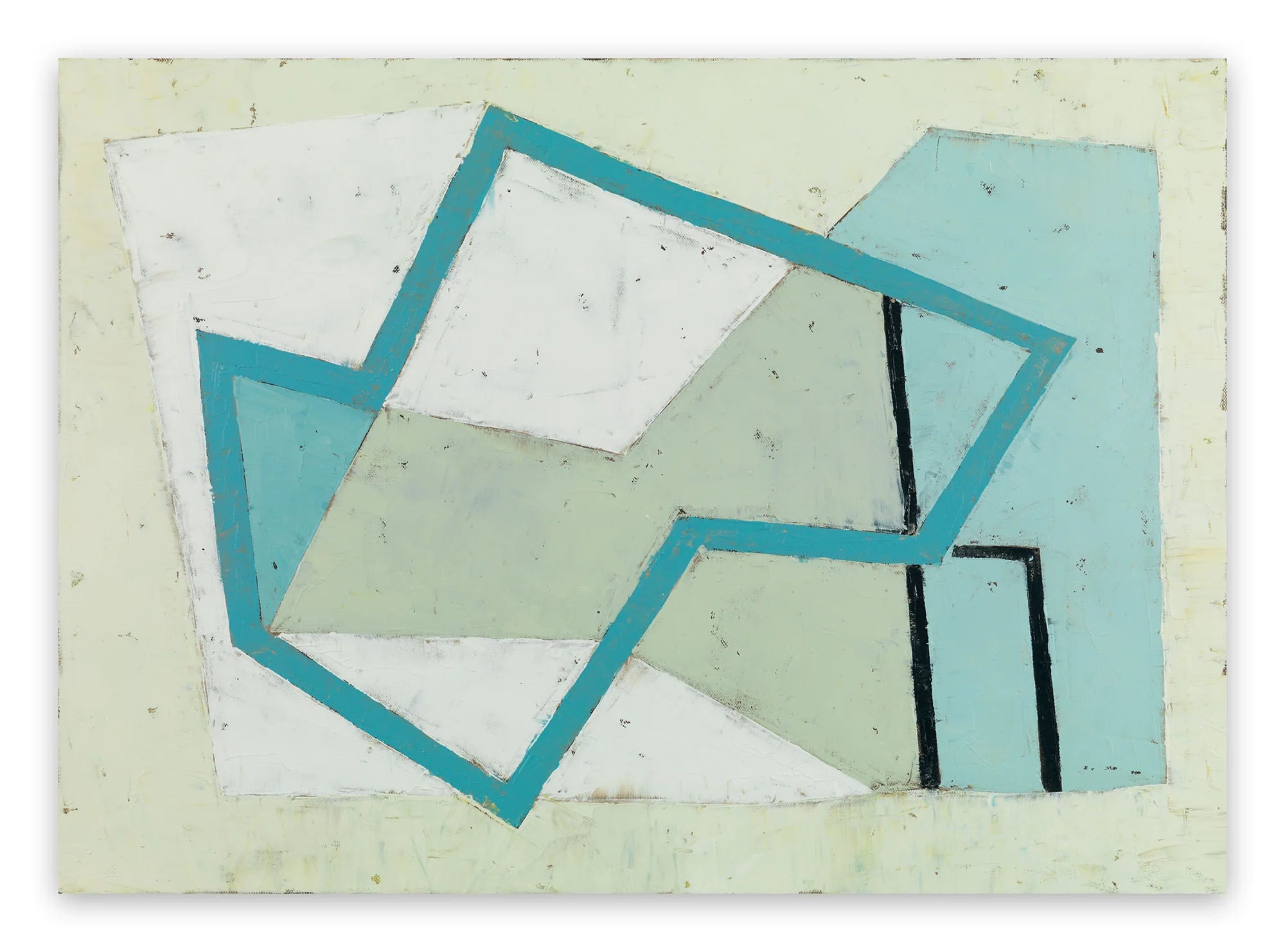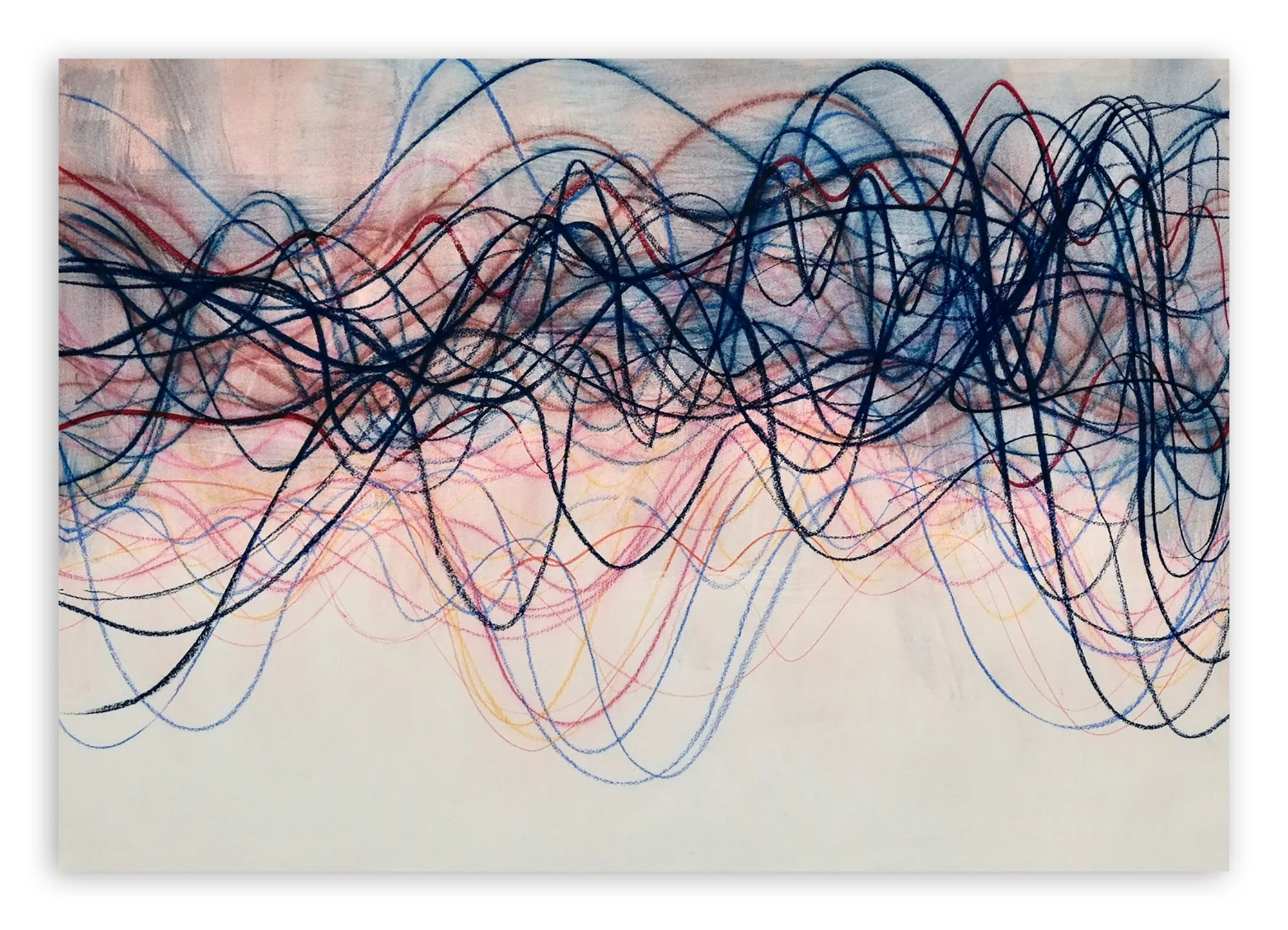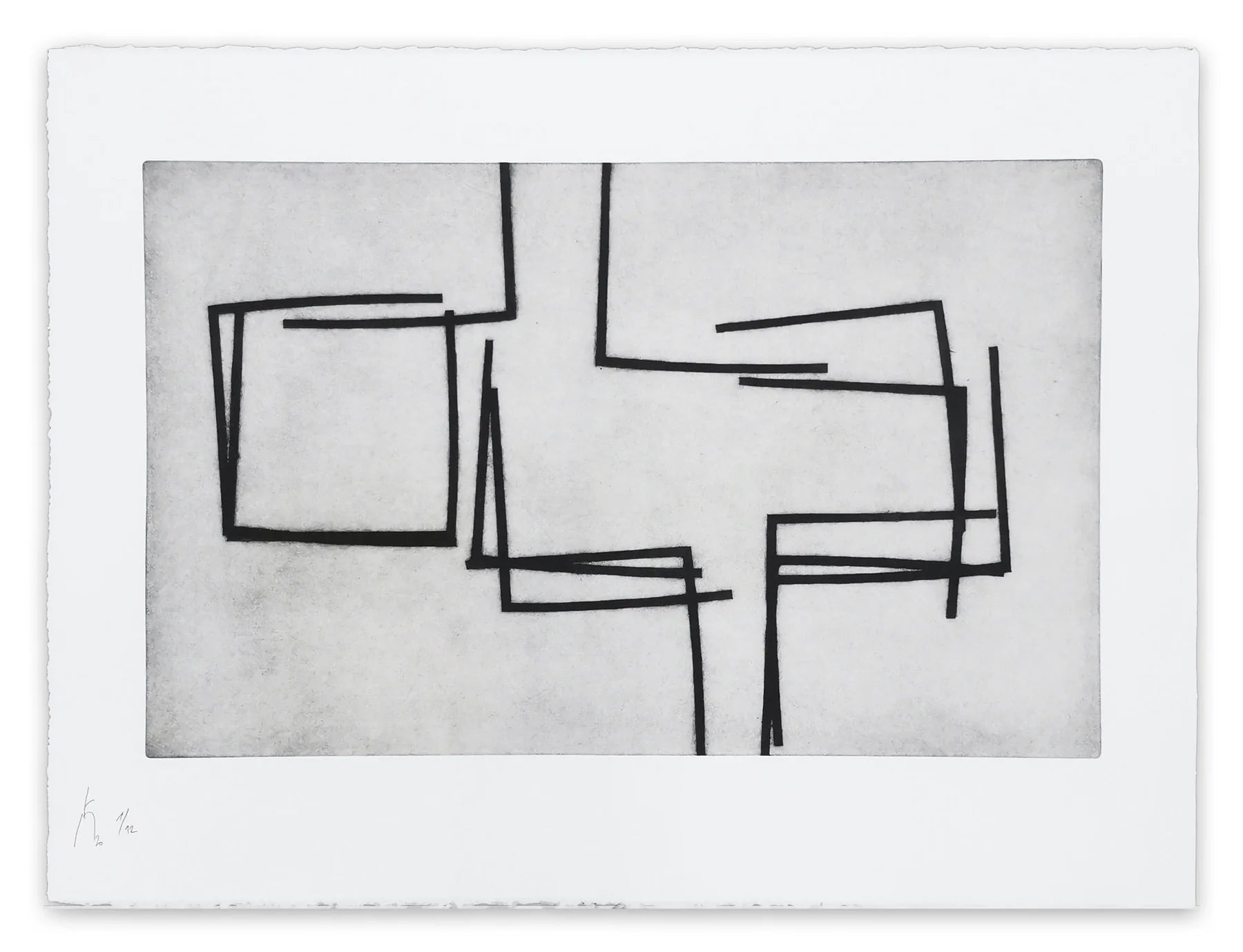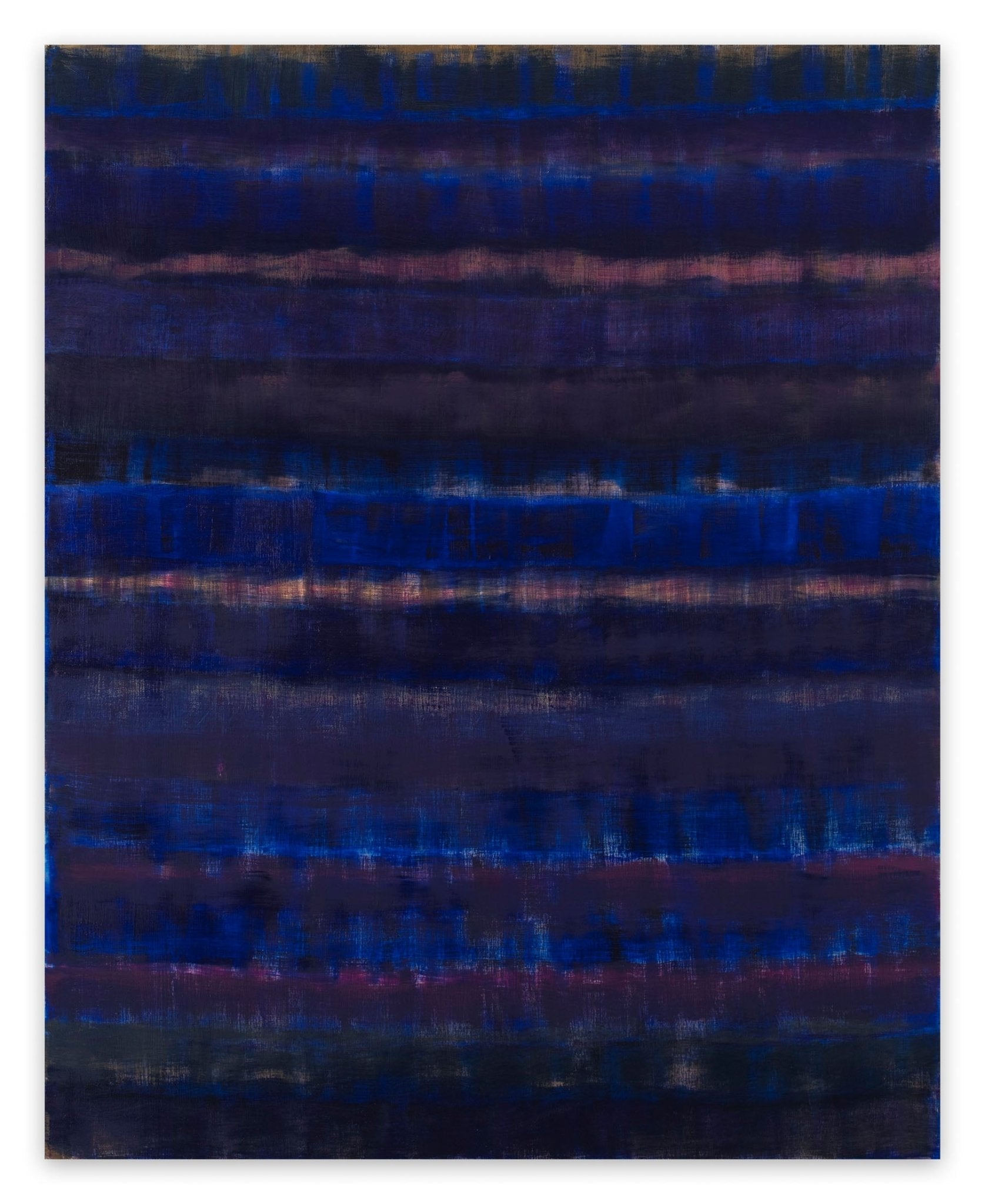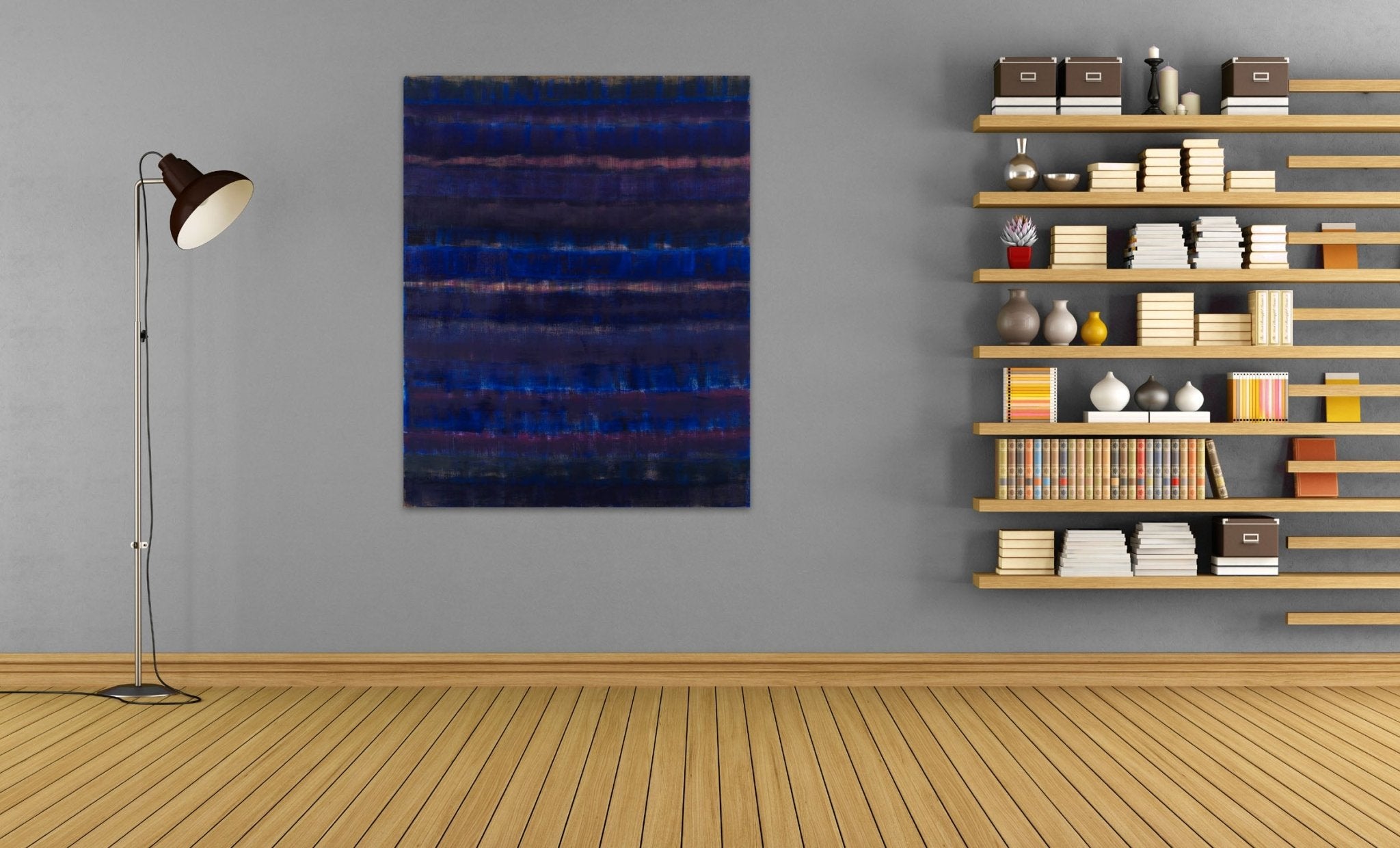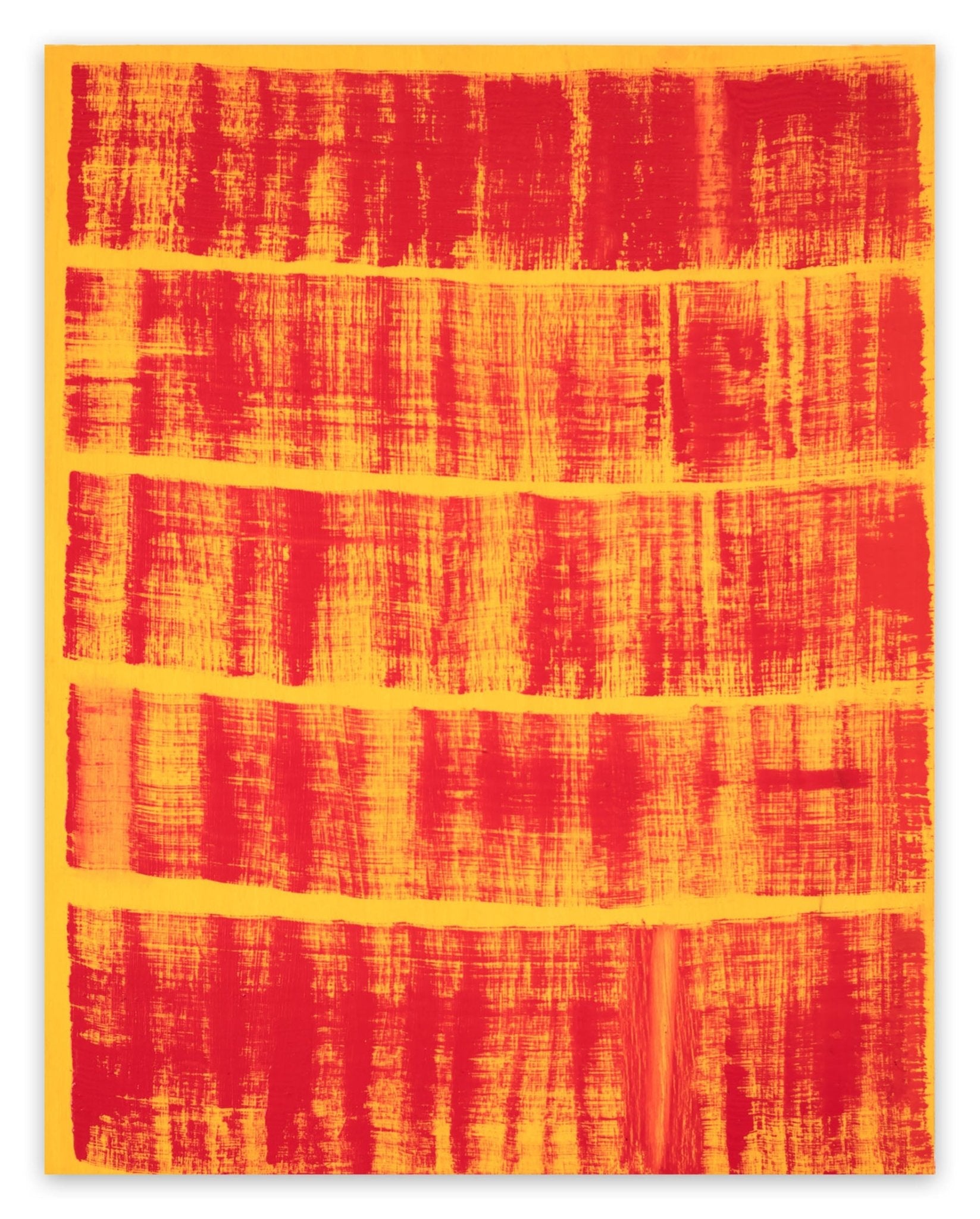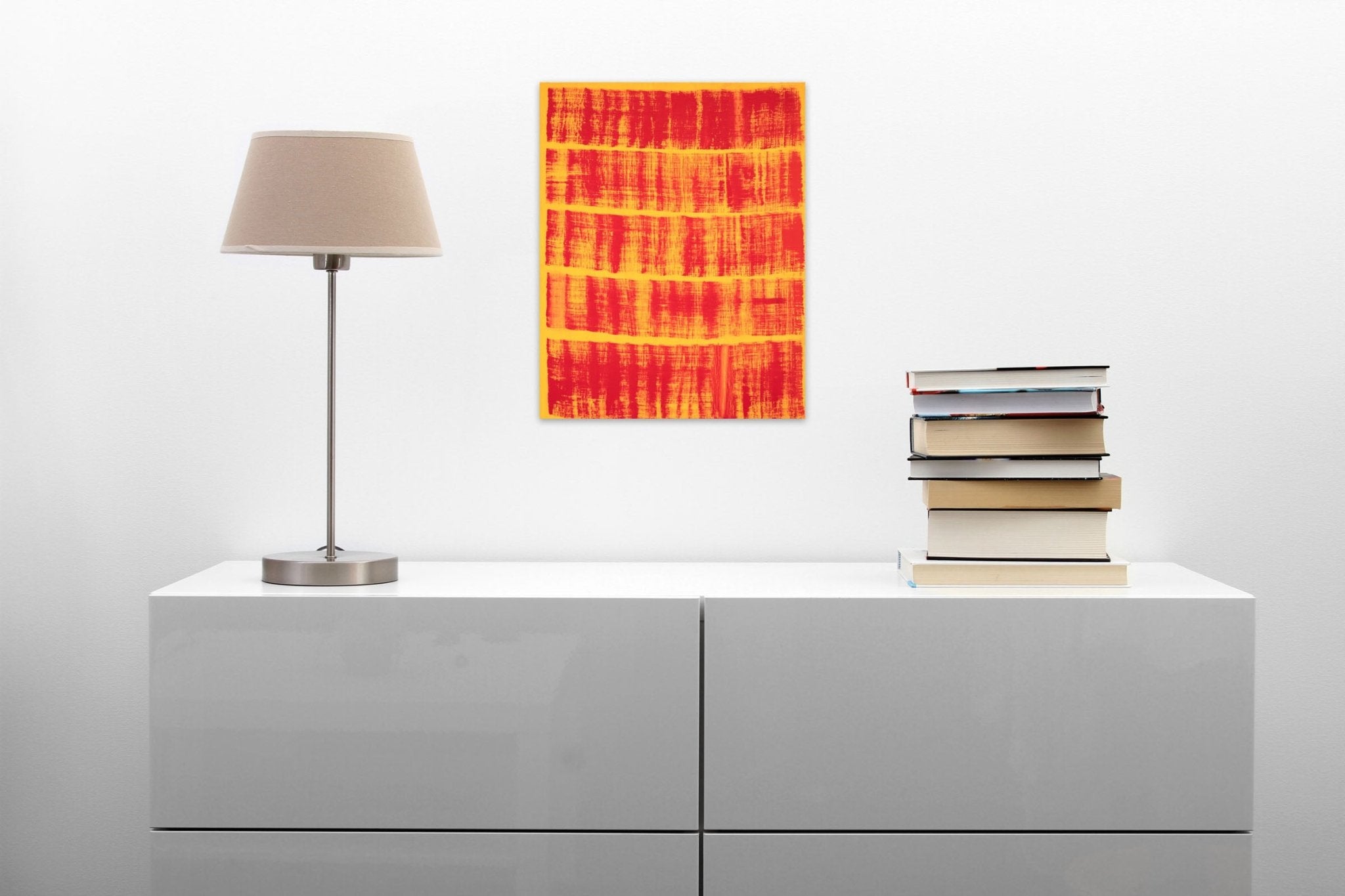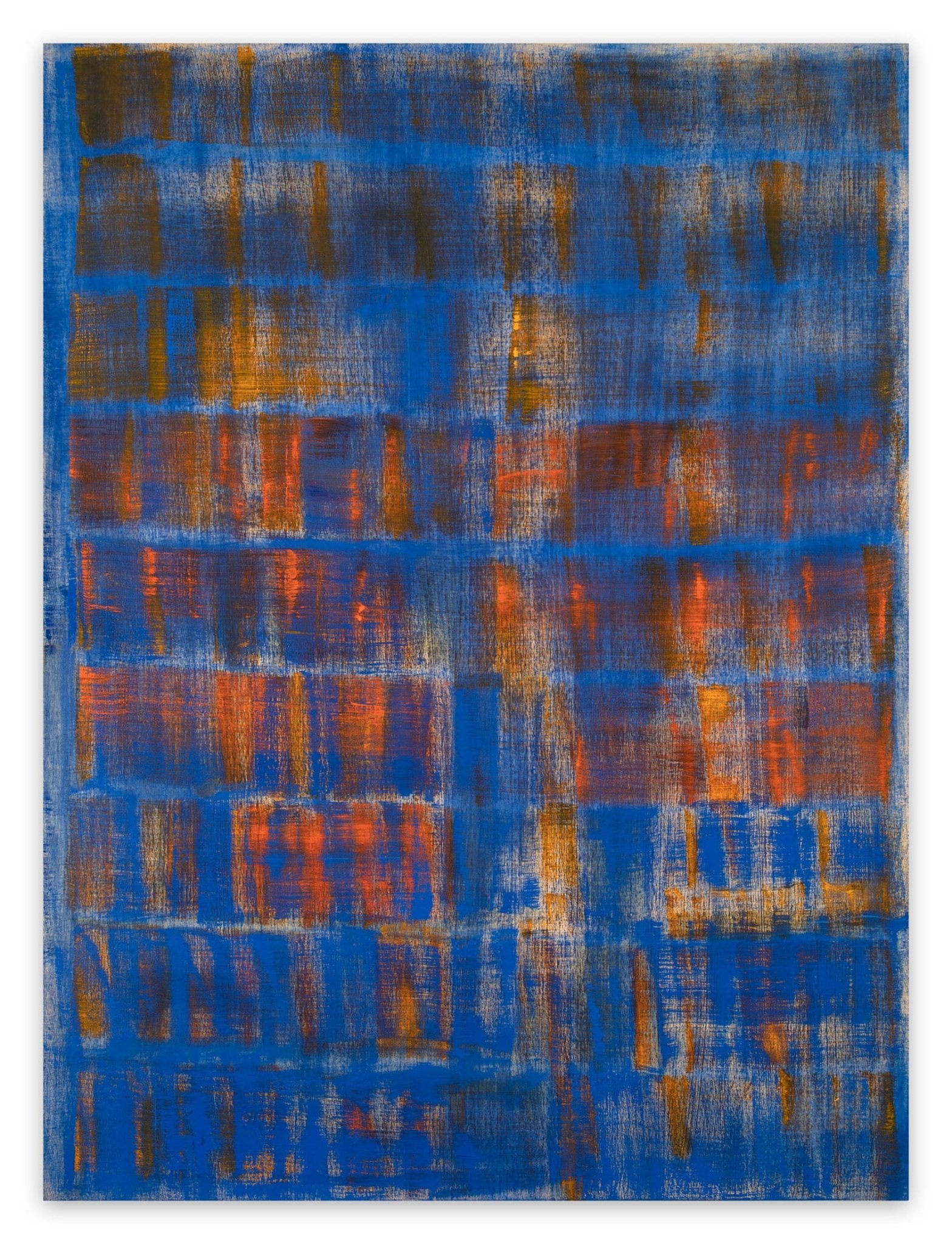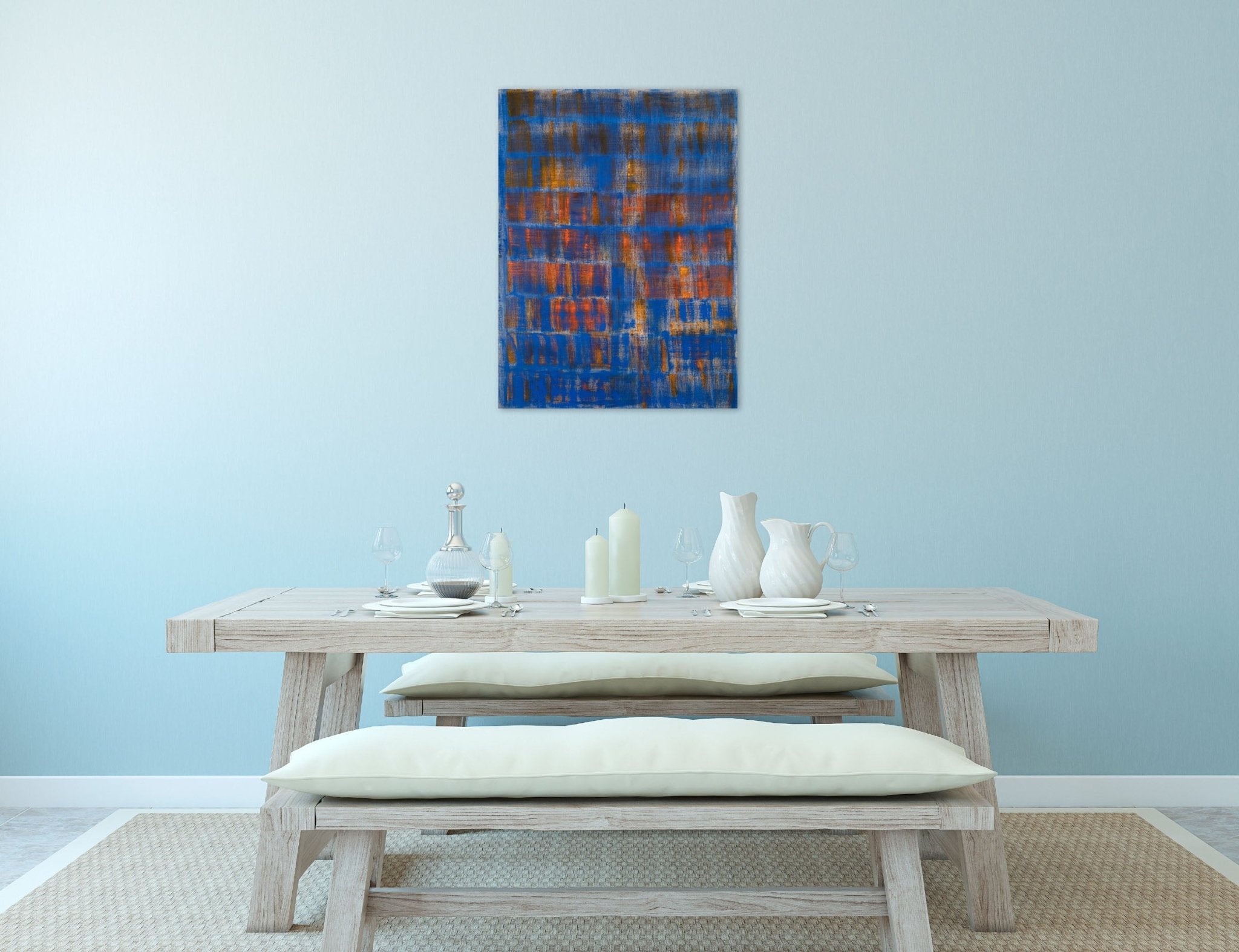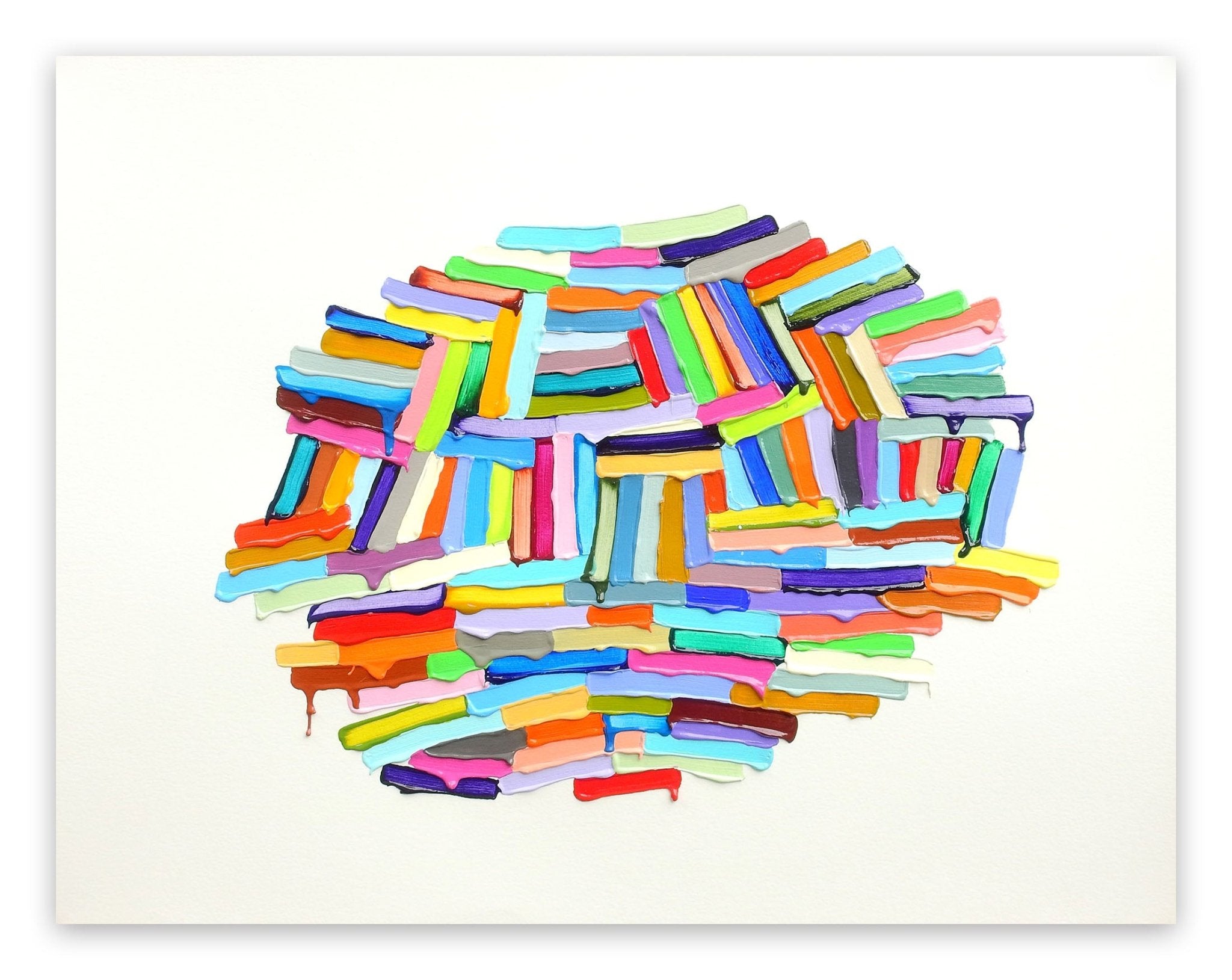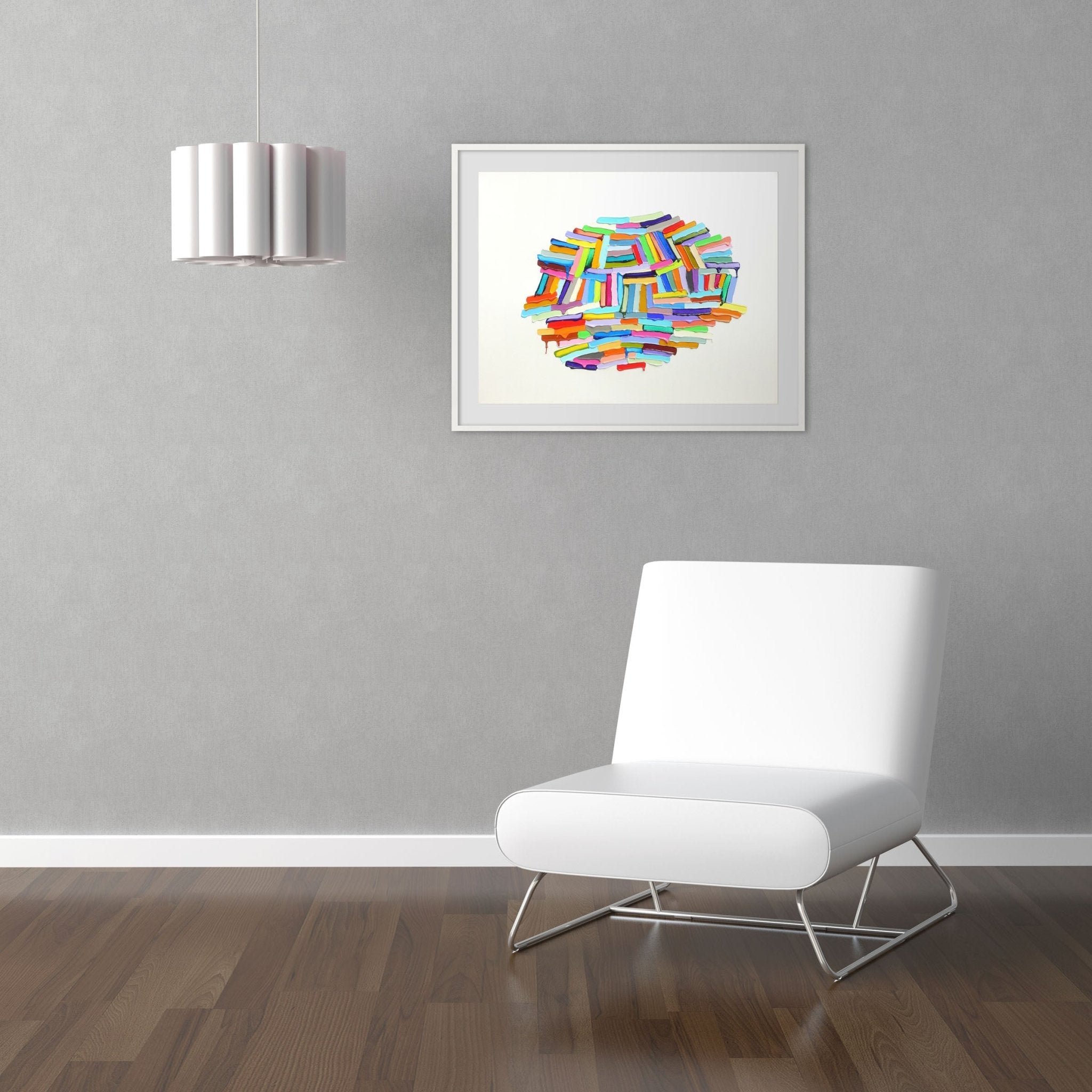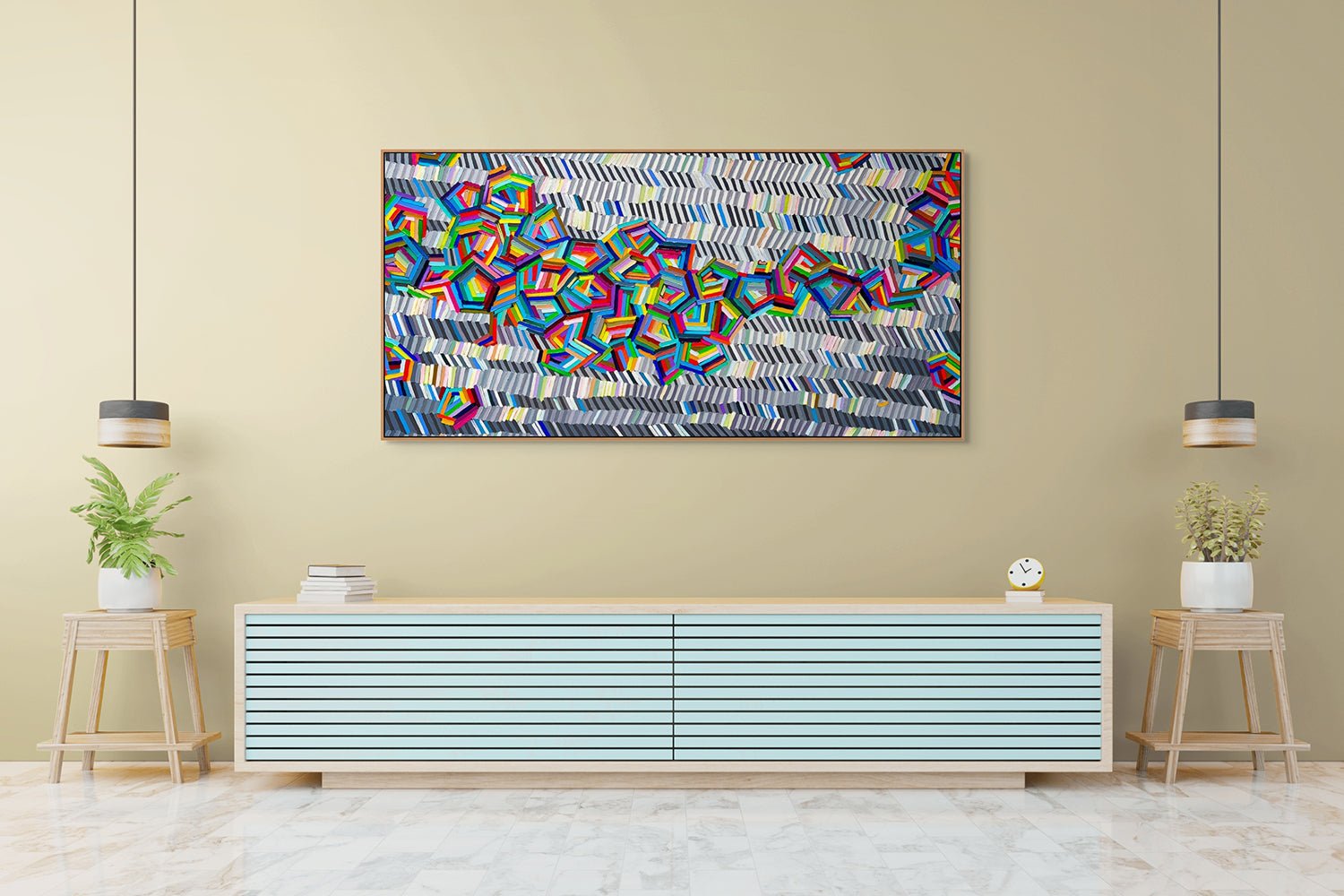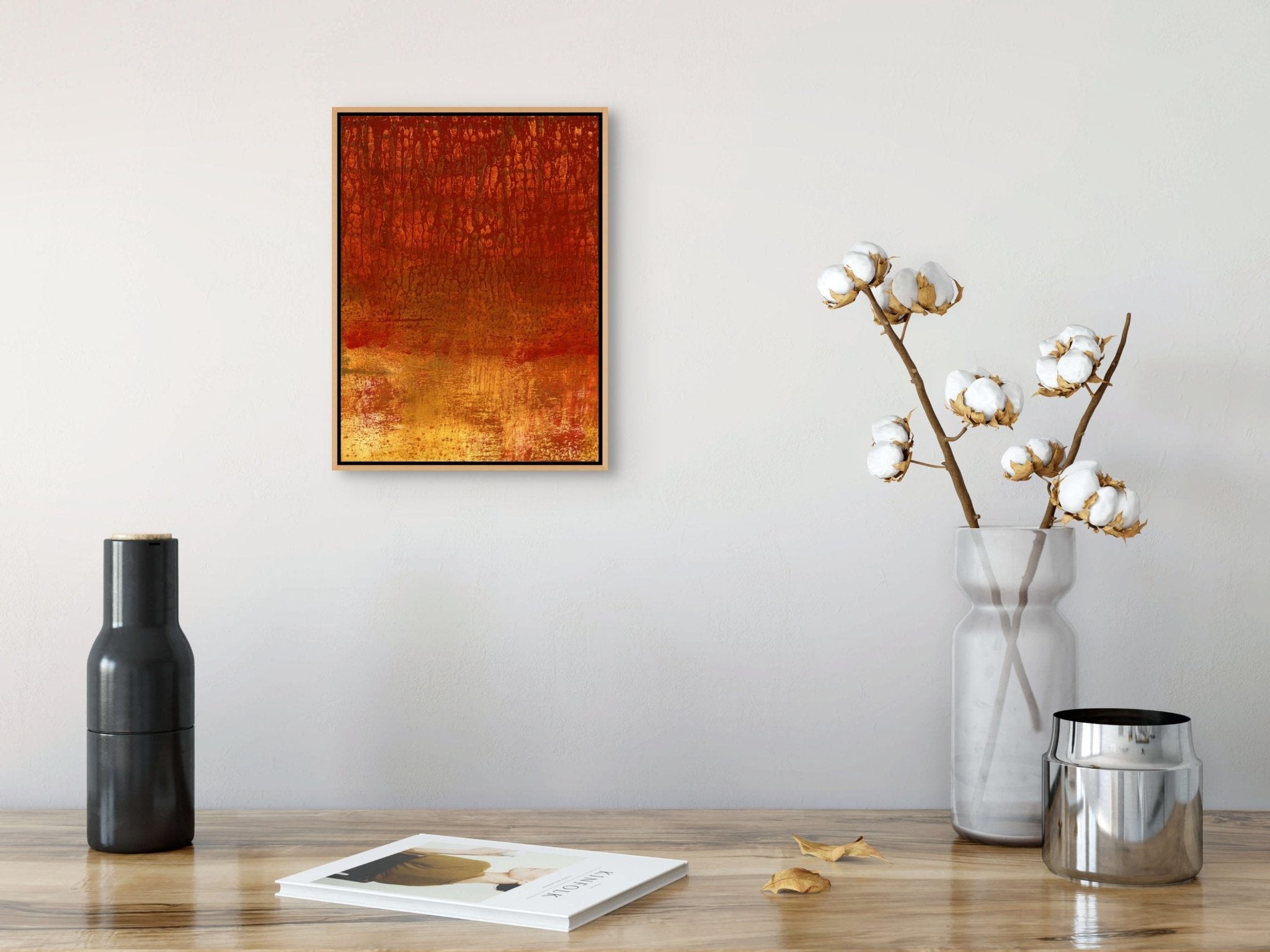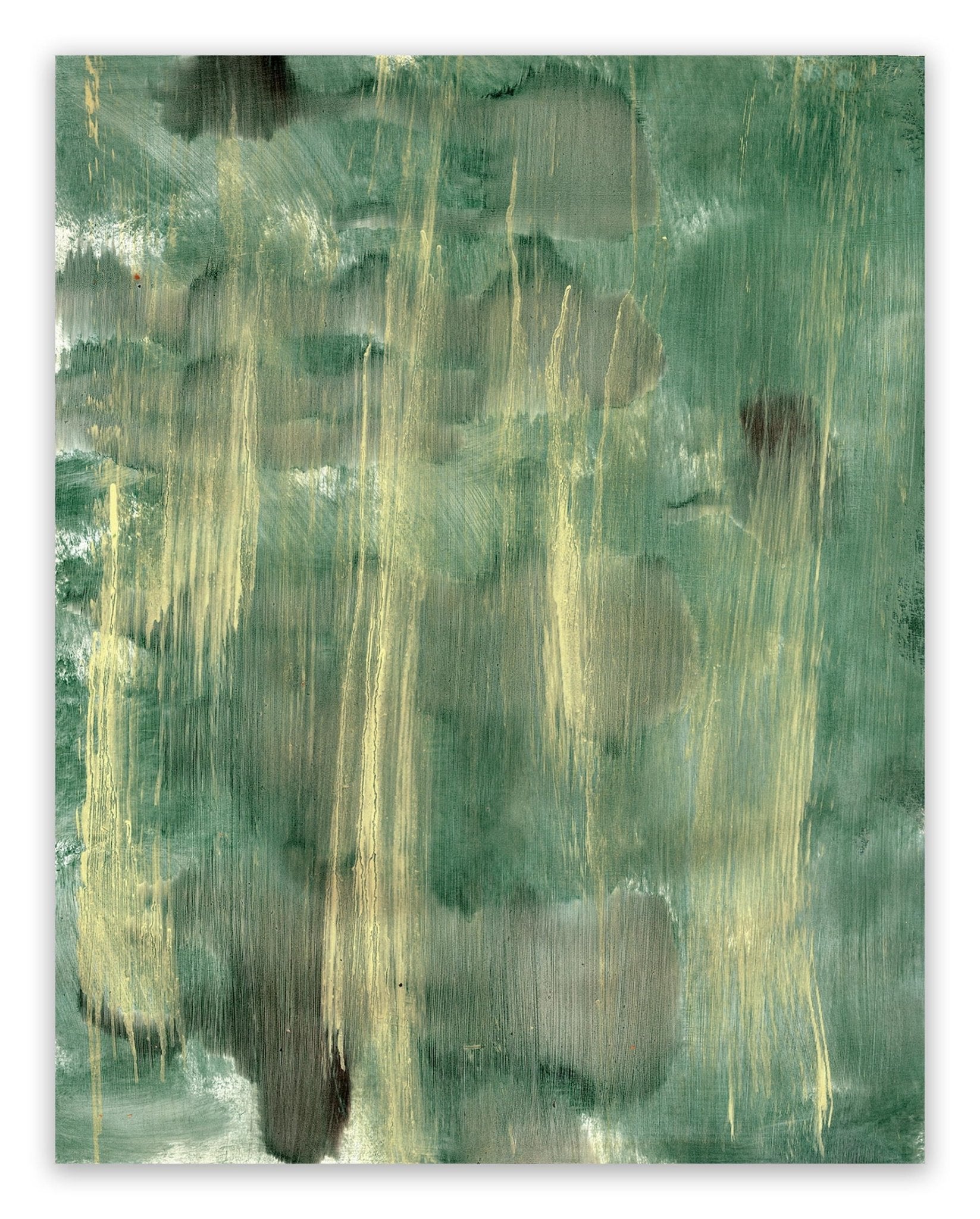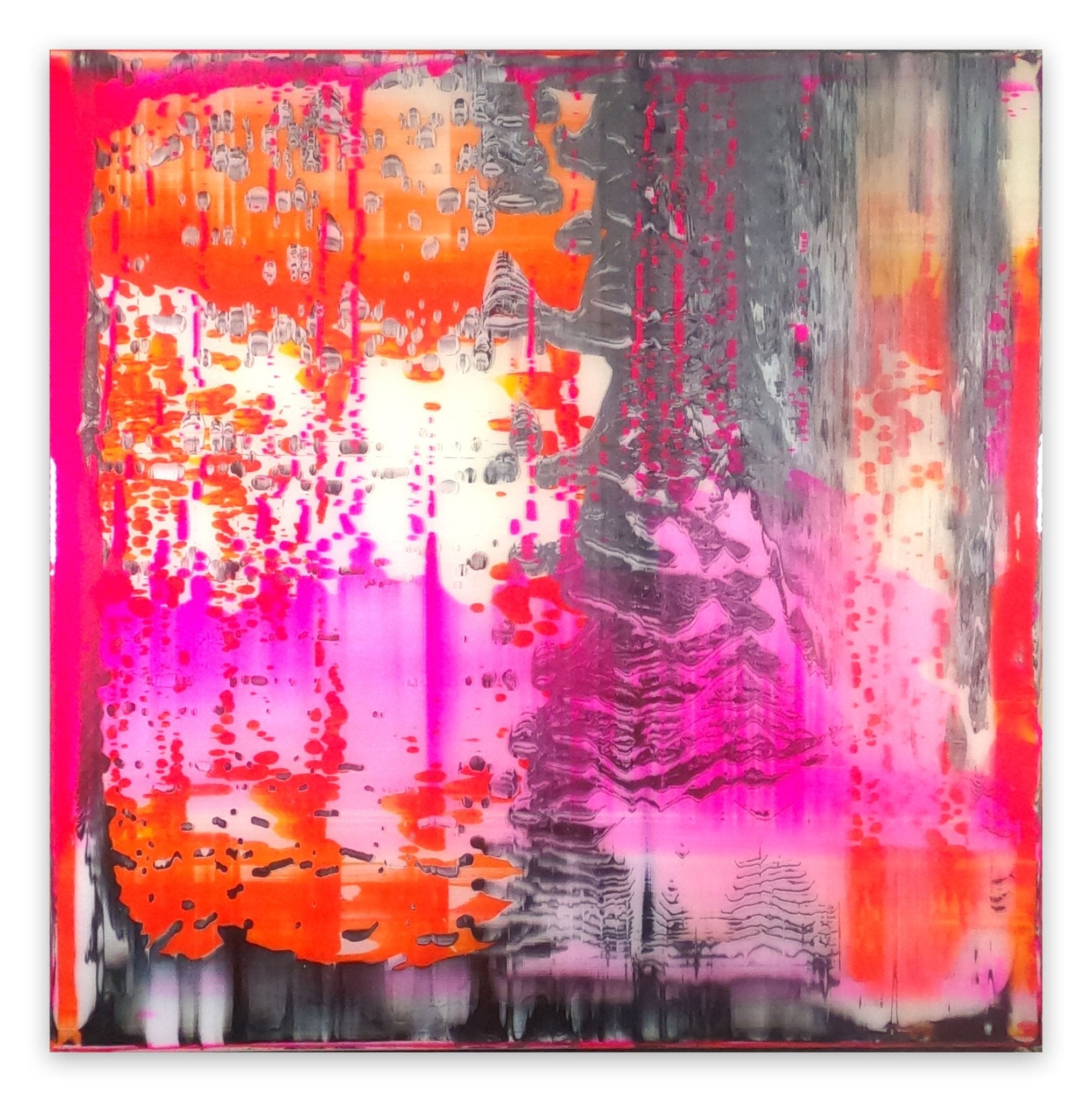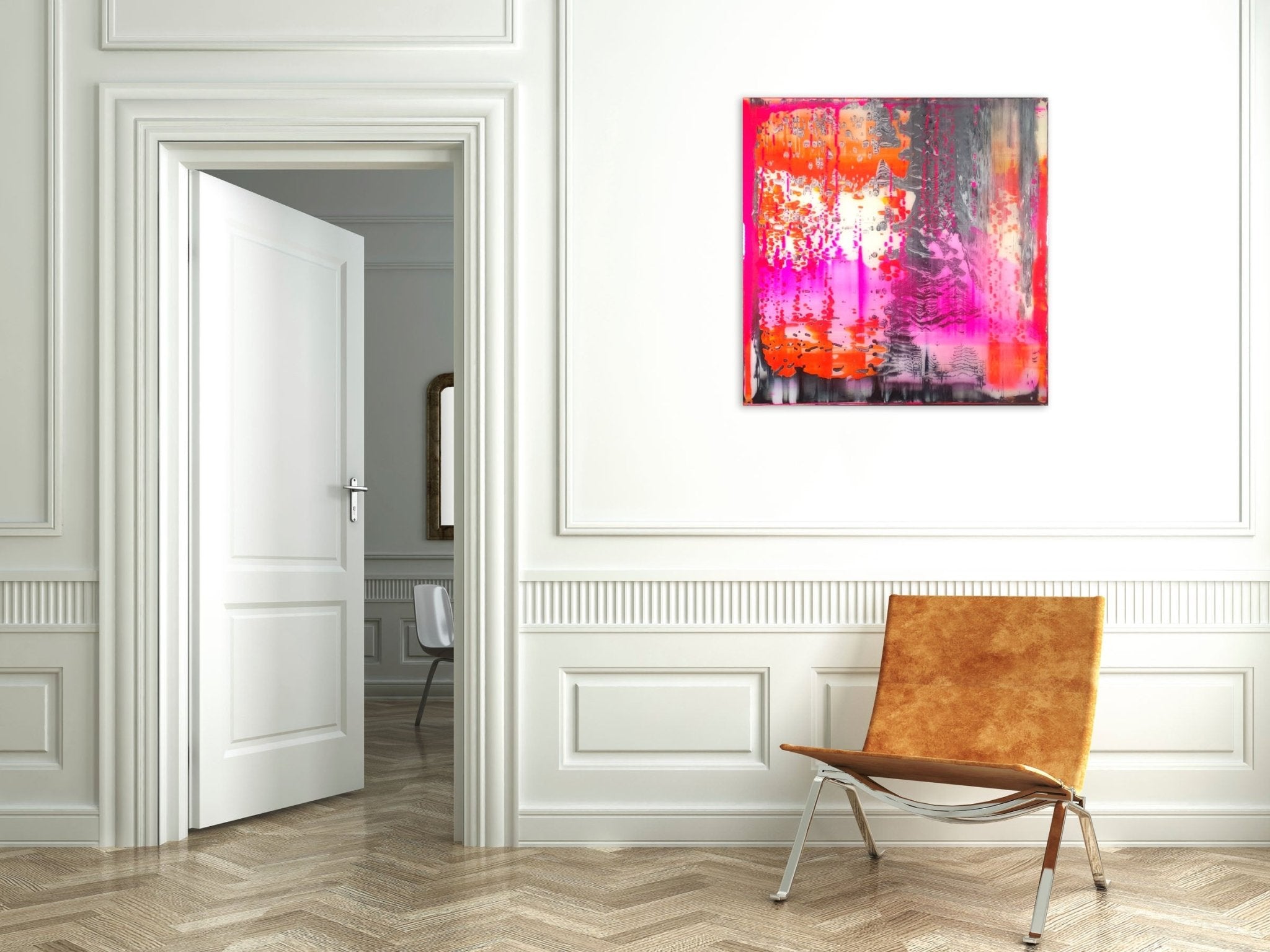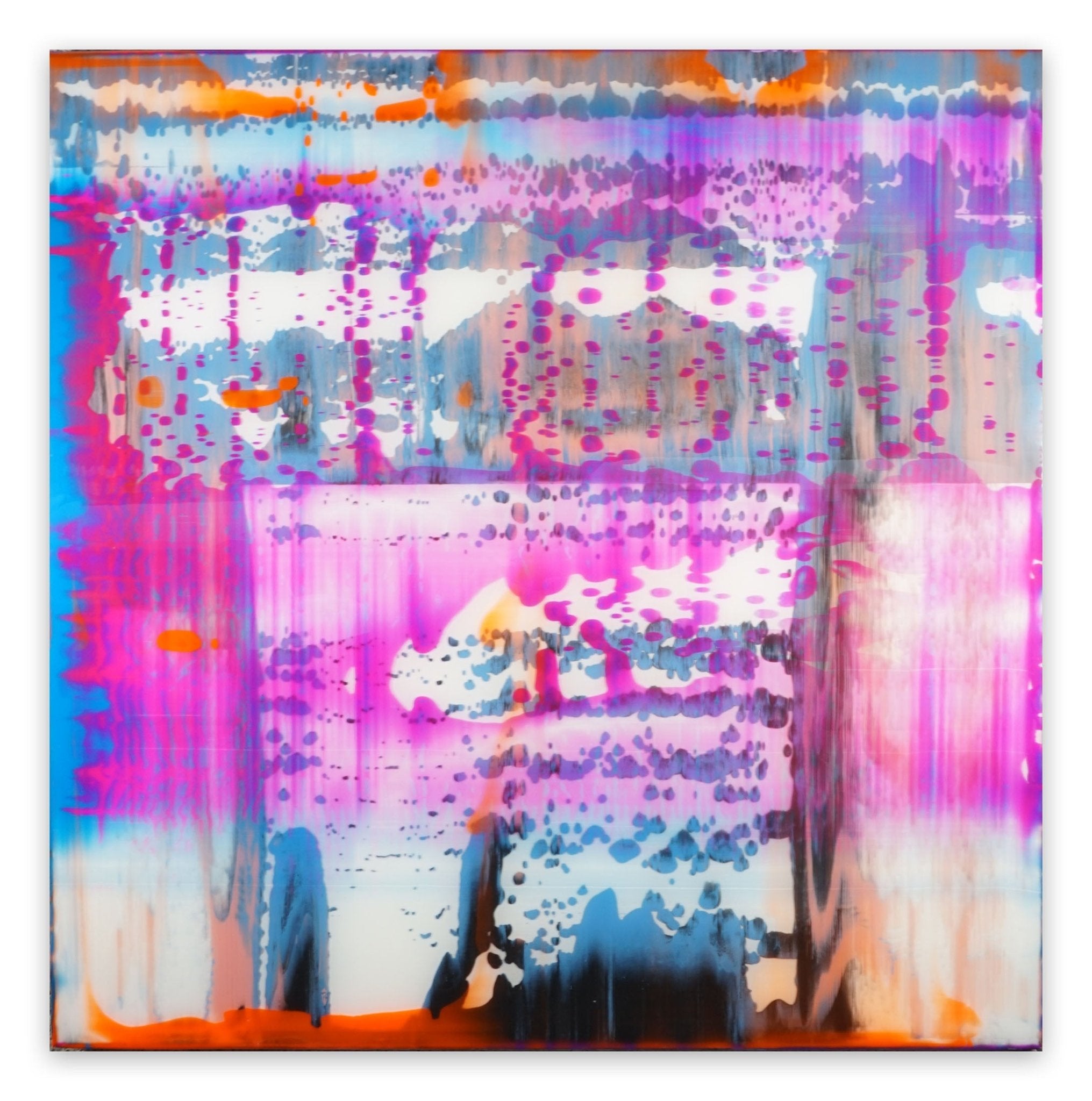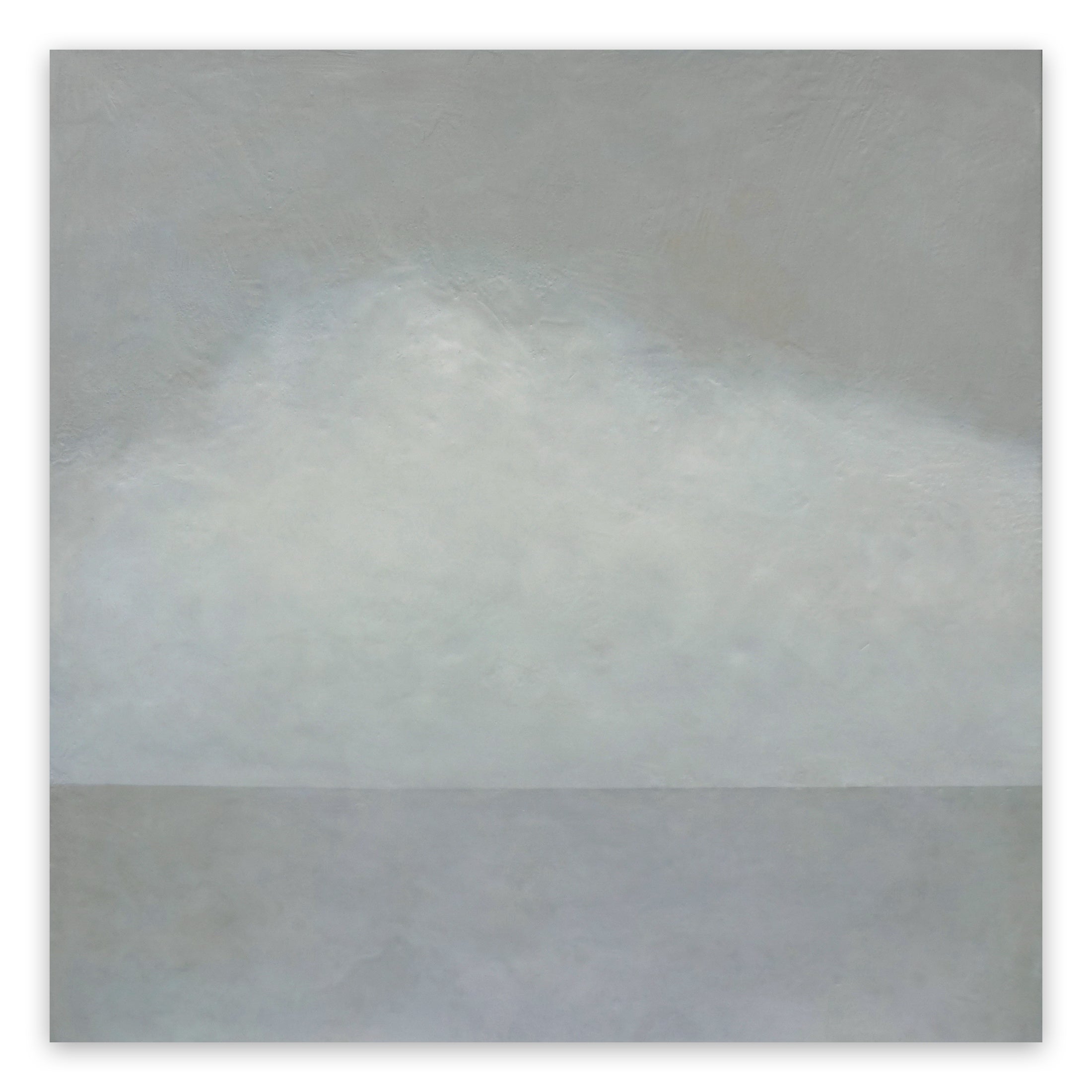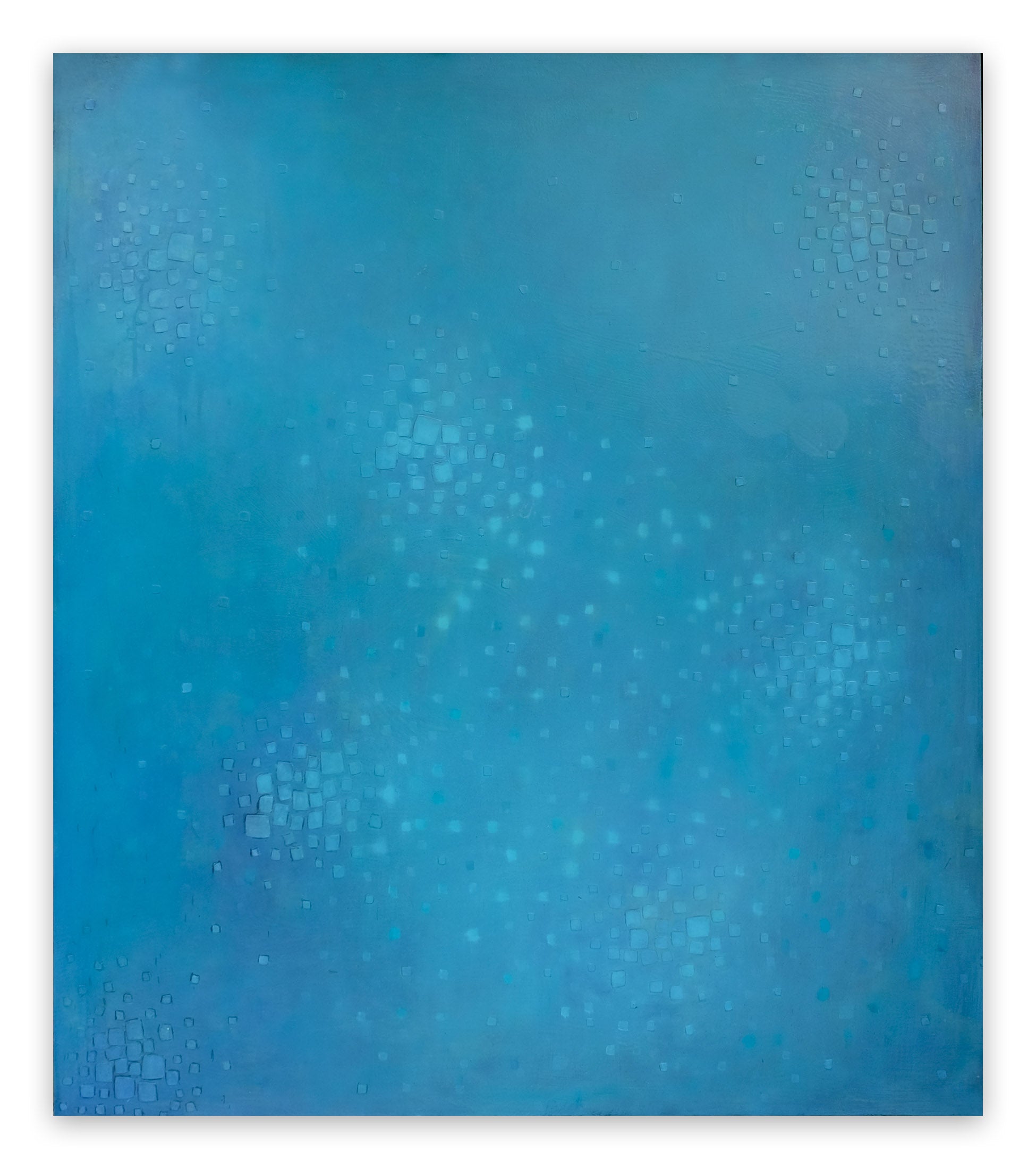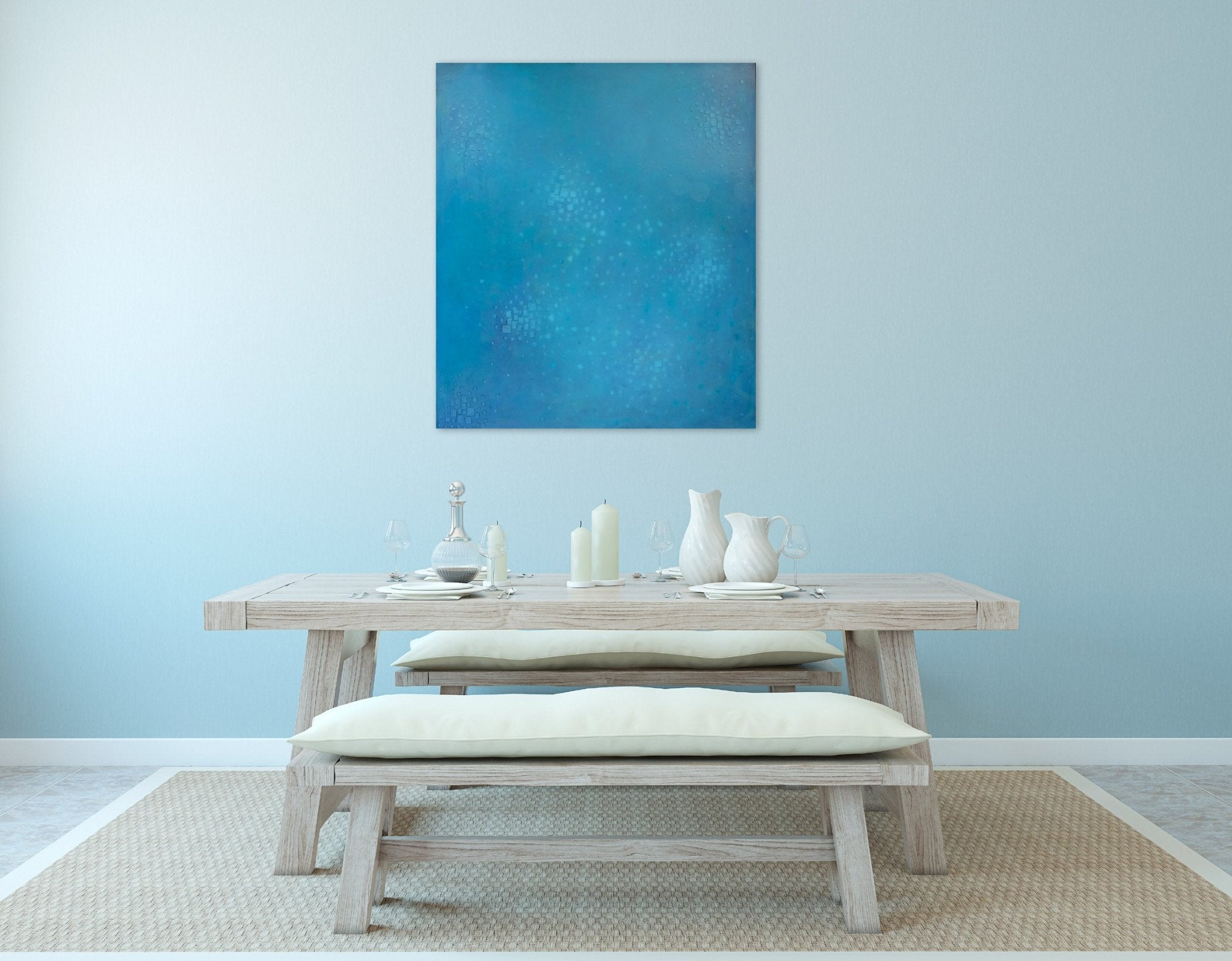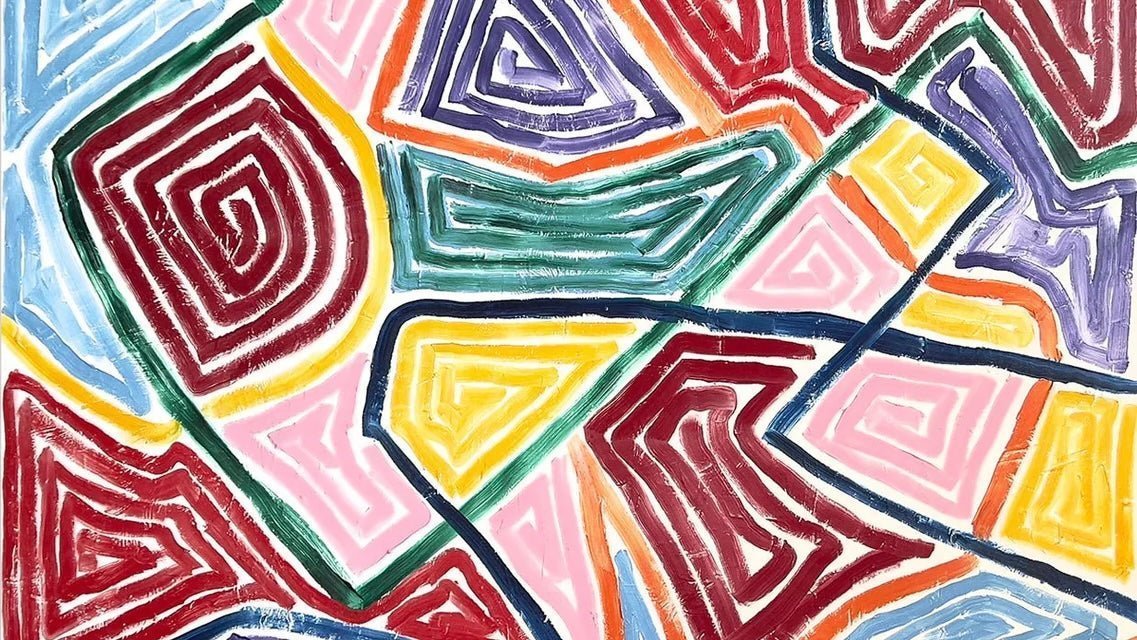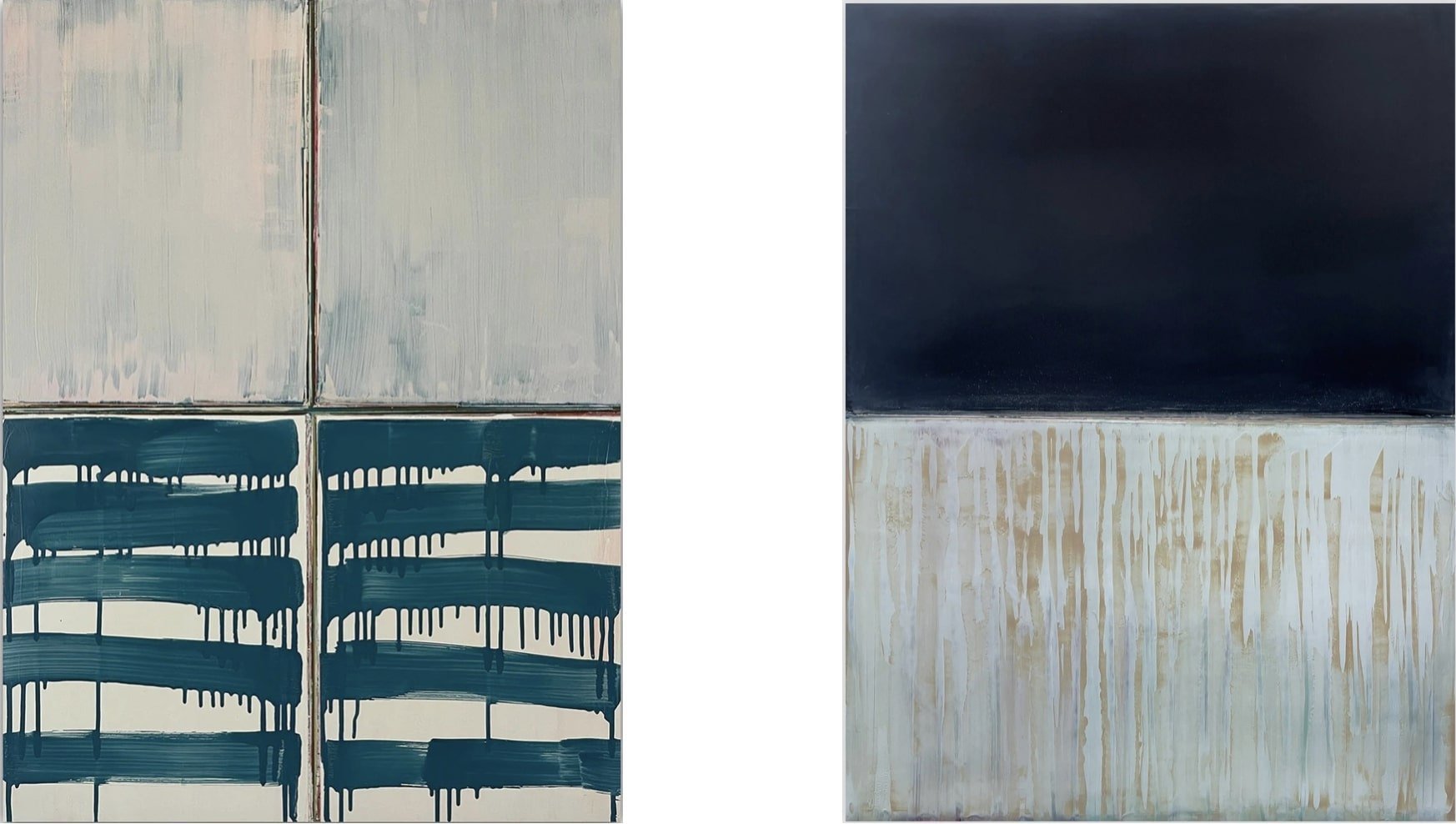
Artistes abstraits très picturaux : les nouveaux alchimistes
Dans son atelier de Heidelberg, Arvid Boecker (image principale) gratte méthodiquement sa toile avec une raclette de sérigraphie. Couche après couche, il construit ce qu'il appelle une « archéologie de la couleur ». À huit mille kilomètres de là, dans son atelier américain, Clay Johnson fait la même chose avec des outils de plâtrier, détruisant et reconstruisant parfois la même section trente fois. Pendant ce temps, à Bruxelles, Janise Yntema chauffe la cire d'abeille à la température exacte avec son chalumeau, ajoutant une autre couche translucide à des mois de travail accumulé.
Ces artistes ne se sont jamais rencontrés, pourtant ils partagent une obsession qui devient de plus en plus rare dans l'art contemporain : la croyance que la peinture elle-même — son poids, sa texture et sa présence physique — détient un pouvoir irremplaçable.

Clay Johnson, After Midnight, 2020
L'art disparu de la patience
Nous vivons à une époque de raccourcis artistiques. Les outils numériques promettent des résultats instantanés. De nouvelles techniques émergent chaque semaine, célébrées simplement pour leur nouveauté. Le monde de l'art, comme tout le reste, a été séduit par la rapidité et la commodité. Les techniques picturales traditionnelles — lentes, laborieuses, impitoyables — semblent presque anachroniques.
Pourtant, disséminés dans des ateliers d'Allemagne à la Californie, de la Belgique aux Pays-Bas, certains artistes continuent de pousser la peinture sur les toiles avec la dévotion des artisans médiévaux. Ils représentent ce que nous pourrions appeler Very Painterly Abstract Art, une pratique définie non par une esthétique partagée, mais par une conviction commune : que la manipulation physique de la peinture crée quelque chose qu'aucun processus numérique ne peut reproduire.
Ce n'est pas de la nostalgie. C'est de la résistance.
Qu'est-ce qui rend l'art « très pictural » ?
Regardez Clay Johnson travailler, et vous comprenez immédiatement. Il n'utilise pas de pinceaux - trop doux, trop prévisibles. À la place, il attaque sa toile avec des couteaux à palette et des outils de construction, grattant, construisant, détruisant, reconstruisant. Sa peinture acrylique sèche assez vite pour qu'il puisse réagir à chaque couche au fur et à mesure, créant des surfaces tellement travaillées qu'elles approchent la sculpture.
Ou observez la Martina Nehrling accumulation méthodique de marques d'impasto, chaque coup de pinceau soigneusement placé s'accrochant à son voisin comme des éléments architecturaux. Ses couleurs pures et opaques créent des motifs hypnotiques qui semblent vibrer d'une énergie physique.
Ce que ces artistes partagent n'est pas un style — leurs œuvres finies sont remarquablement différentes. Ce qu'ils partagent, c'est le processus : un engagement obsessionnel envers la peinture comme matériau, la surface comme sujet, le temps rendu visible à travers des couches accumulées.

Martina Nehrling, Apophis, 2024
Les quatre piliers de l'Art Très Peint
À travers une observation attentive de leurs pratiques, quatre principes fondamentaux émergent qui définissent l'Art Abstrait Très Peint. Ce ne sont pas des règles mais des obsessions, des forces motrices qui façonnent chaque décision en atelier.
Honnêteté matérielle
Ces artistes ne cherchent pas à faire ressembler la peinture à autre chose. Yari Ostovany célèbre la façon dont le pigment se dissout, couvre, s'efface, se dissout à nouveau. Danny Giesbers construit des couches transparentes qui créent des champs lumineux, chaque coup de pinceau jouant un rôle crucial dans une composition globale qui a pris des mois à être achevée. La peinture est autorisée à être peinture — visqueuse, opaque, obstinée, belle en soi.
Profondeur temporelle
Chaque couche représente une décision, un moment dans le temps, une réponse à ce qui l'a précédée. Les surfaces en relief de Jeremy Annear deviennent des sites archéologiques de prise de décision créative. Vous pouvez lire l'histoire de chaque peinture dans sa topographie — où l'artiste a accumulé, gratté, changé de direction, trouvé une résolution.
Engagement physique
Ces œuvres nécessitent des corps, pas seulement des esprits. Robert Niesse construit et détériore plusieurs sections de couleur par des processus physiques complexes. Emily Berger travaille avec des larges gestes horizontaux, tout son corps impliqué dans chaque marque. Les peintures portent les traces d'un effort humain qu'aucun assistant ne pourrait reproduire, qu'aucun processus numérique ne pourrait simuler.
Résistance à la reproduction
Peut-être plus important encore, ces œuvres ne peuvent pas être pleinement appréciées à travers des écrans. Elles exigent une présence physique pour une compréhension complète. À l'ère d'Instagram, cela représente une déclaration artistique audacieuse : certaines expériences ne peuvent pas être numérisées, certains plaisirs ne peuvent pas être partagés virtuellement.

Jeremy Annear, Cascading Lines, 2013
Le courage de l'anachronisme
Il faut du courage pour travailler ainsi en 2025. Alors que d'autres artistes explorent la collaboration avec l'IA, les possibilités des NFT et les installations spectaculaires, ces peintres se retirent dans leurs ateliers pour des mois de travail solitaire. Ils adoptent des techniques qui n'offrent aucun raccourci, aucune gratification instantanée, aucun potentiel viral.
Les peintures de Arvid Boecker émergent d'une construction patiente — dessinant d'abord la composition au crayon, puis faisant évoluer les couleurs et les couches sur de longues périodes. Chaque œuvre devient une carte topographique d'attention soutenue. Dans une culture qui valorise l'immédiat, il insiste sur l'éventuel.
Janise Yntema travaille avec la cire encaustique, une technique littéralement ancienne — utilisée par les Romains, perfectionnée au fil des millénaires. Dans son atelier, elle applique de la cire d'abeille naturelle et de la résine sur des panneaux de bois, utilisant la chaleur comme solvant actif. Par des accumulations lentes de couches semi-transparentes, elle crée des images où la lumière devient elle-même présente dans la composition. Son processus requiert ce qu'elle appelle « une danse alchimique entre le dirigé et l'incontrôlé » — l'opposé de la prévisibilité numérique.

Danny Giesbers, Neon 1 (gauche) et Dan Flavin (droite), 2020
Échos Historiques, Urgence Contemporaine
Cette approche se connecte à des précédents illustres. Les peintures au racloir de Gerhard Richter démontrent le dialogue ultime entre contrôle et hasard à travers des surfaces fortement travaillées. Frank Auerbach et Leon Kossoff ont transformé l'impasto en relief sculptural. Anselm Kiefer a incorporé sable, cendres et mémoire dans des surfaces portant le poids de l'histoire.
Mais les artistes Very Painterly Abstract d'aujourd'hui font face à un contexte culturel différent. Là où leurs prédécesseurs luttaient contre la domination de la photographie et des médias de masse, ces artistes s'opposent à la domination de la culture numérique elle-même. Ils ne font pas que peindre ; ils préservent une façon de penser, un mode d'engagement, un type d'expérience.

Emily Berger, Old Flame (gauche) et Red Dream (droite), 2022
La Persistance Internationale
Ce qui est remarquable, c'est la façon dont cet engagement apparaît à travers les cultures et les continents. Danny Giesbers aux Pays-Bas développe des approches algorithmiques combinées à des marques spontanées. Sa série « Shifts » intègre des peintures phosphorescentes qui se transforment selon les conditions d'éclairage — la surface fortement travaillée devient un participant de sa propre évolution continue.
Emily Berger superpose de la peinture à l'huile sur des panneaux de bois en Californie, créant des dynamiques de poussée et de traction grâce à des couleurs complémentaires qui confèrent à ses compositions une luminosité nuancée. Par grattage et frottis, elle fait le lien entre le geste de l'expressionnisme abstrait et la conscience contemporaine des matériaux.
Robert Niesse construit des couches brillantes alternant avec des marques signatures puissantes, créant ce qu'il décrit comme « un contexte brutal et une conclusion des compositions de couleur ». Son approche systématique mais intuitive reflète un background en design tout en embrassant l'expression abstraite spontanée.
Chaque artiste apporte une spécificité culturelle à une obsession matérielle partagée, enrichissant le vocabulaire tout en maintenant un engagement essentiel envers des surfaces intensément travaillées et une profondeur temporelle.

Yari Ostovany, Voici où nous nous rencontrons (Pour John Berger), 2015
Pourquoi cela importe maintenant
En défendant Very Painterly Abstract Art, nous défendons plus qu'une préférence esthétique. Nous défendons la valeur d'un engagement soutenu, de processus qui ne peuvent être accélérés, d'expériences qui ne peuvent être numérisées.
Ces artistes nous rappellent que malgré les avancées technologiques, quelque chose d'irremplaçable existe dans la manipulation directe et physique des matériaux. Leurs surfaces intensément travaillées se dressent comme des monuments à la créativité humaine — des témoignages d'un engagement soutenu entre l'artiste et le médium qu'aucun processus numérique ne peut reproduire.
Le marché reconnaît cette irremplaçabilité. Certains collectionneurs recherchent des œuvres qui exigent une présence physique pour une compréhension complète, des peintures qui révèlent de nouveaux détails à chaque regard, des surfaces qui changent avec la lumière et la perspective. Les artistes de Very Painterly Abstract offrent exactement cette expérience.

Robert Niesse, 2121-6, 2024
L'avenir de la résistance
À mesure que la culture numérique devient plus omniprésente, Very Painterly Abstract Art devient plus précieux — non pas comme curiosité historique, mais comme nécessité contemporaine. Ces artistes ne préservent pas le passé ; ils garantissent que certains types d'expérience humaine restent possibles.
Ils représentent les derniers alchimistes à une époque où tout est instantané, transformant les matières premières en expériences irremplaçables grâce au temps, à la patience et à l'engagement physique. Leurs ateliers deviennent des sanctuaires où différentes relations au temps et à la création restent possibles.
En célébrant ces artistes, nous célébrons non seulement la réussite individuelle, mais aussi la vitalité continue de pratiques qui refusent tout compromis avec la rapidité. Ils veillent à ce que la peinture reste non seulement pertinente mais essentielle, offrant quelque chose d'encore plus rare : l'opportunité de rencontrer des traces physiques de la pensée et du sentiment humain soutenus.
Leurs surfaces épaisses de peinture portent plus que du pigment : elles portent la conviction que certaines choses ne peuvent être précipitées, numérisées ou simplifiées. Dans notre époque accélérée, ils insistent sur la décélération. Dans notre monde virtuel, ils exigent une présence physique. À notre époque de reproduction infinie, ils créent l'irremplaçable.
C'est leur courage, leur don et leur héritage.
